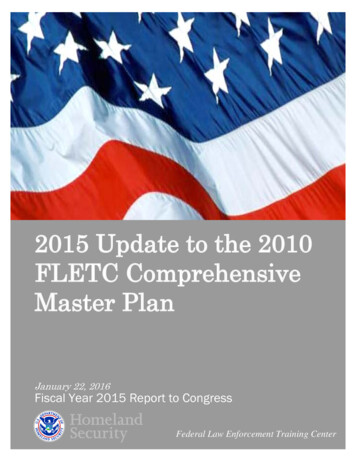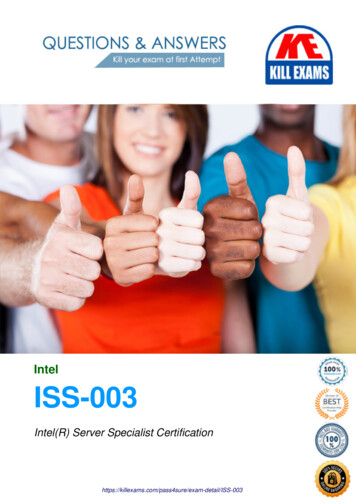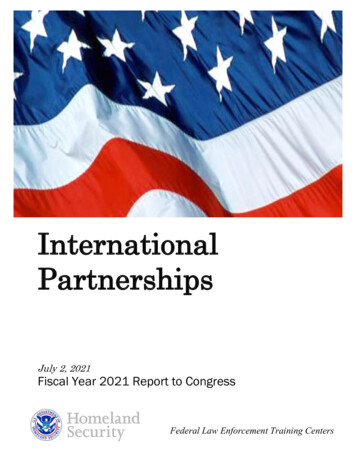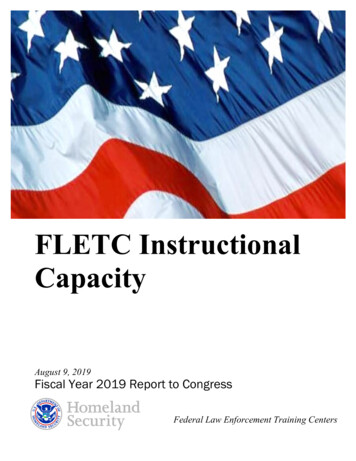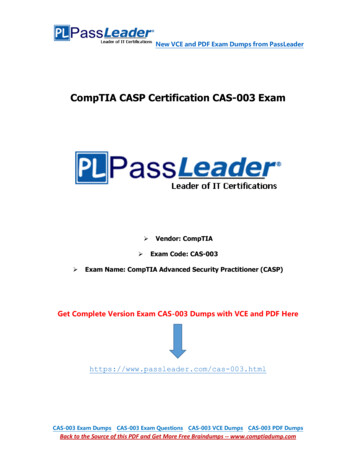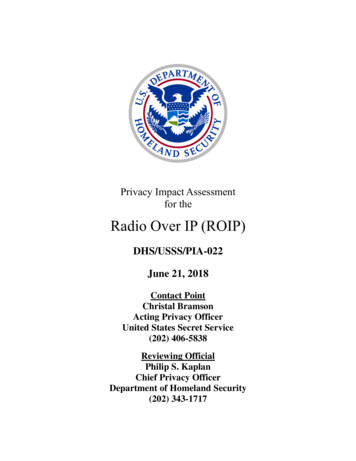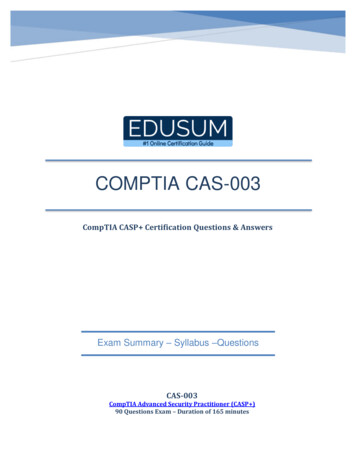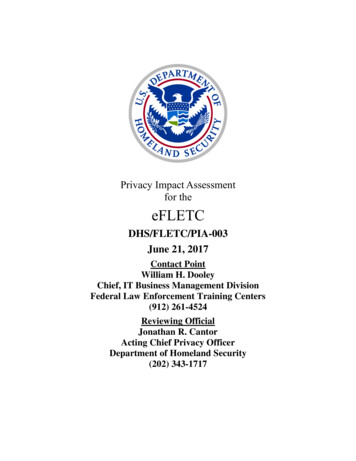
Transcription
Privacy Impact Assessmentfor theeFLETCDHS/FLETC/PIA-003June 21, 2017Contact PointWilliam H. DooleyChief, IT Business Management DivisionFederal Law Enforcement Training Centers(912) 261-4524Reviewing OfficialJonathan R. CantorActing Chief Privacy OfficerDepartment of Homeland Security(202) 343-1717
Privacy Impact AssessmentDHS/FLETC/PIA-003 eFLETCPage 1AbstractThe Federal Law Enforcement Training Centers (FLETC) is implementing eFLETC as anew virtual learning management environment supporting law enforcement training for federal,state, local, tribal, and international law enforcement officers. eFLETC will initially serve as ascheduling, instructional delivery, and records system for up to 14,000 students who may accesseFLETC in the first year. The project automates and integrates processes to improve the efficiencyof administrative support functions for online student training and registration, content delivery,and course analytics. FLETC is conducting this Privacy Impact Assessment (PIA) because, whenfully implemented, eFLETC will collect, maintain, use, and disseminate personally identifiableinformation (PII) about all law enforcement officers who are registered users of the system.OverviewThe Federal Law Enforcement Training Centers (FLETC) serves a leadership role as theFederal Government’s principal provider of world-class, interagency training of federal lawenforcement personnel. FLETC prepares new and experienced law enforcement professionals tofulfill their responsibilities in a safe manner and at the highest level of proficiency. FLETC deliversinteragency training with optimal efficiency through the government-wide sharing of facilities,equipment, and expertise that produces economies of scale available only from a consolidated lawenforcement training organization. FLETC is in the process of architecting and developing anonline training delivery capability that will provide law enforcement training and education inmultiple delivery strategies and modalities.FLETC currently provides law enforcement training to over 90 Partner Organizations.FLETC also trains state, local, tribal, campus, and international law enforcement officers andagents. The number of agencies attending training, the number of students trained, and the numberof student-weeks delivered has steadily increased over the course of FLETC’s history. FLETC’scollaborative approach with its Partner Organizations uses research, training, and education in ashared mission of protecting our democratic institutions, ensuring public safety, and preservinglaw and order. More than 60,000 students are trained annually at FLETC training centers.FLETC seeks to become a provider of virtual learning and services for the law enforcementcommunity. FLETC is identifying and employing critical information technology (IT) and fiscalresources in focused and direct ways in an effort to forward the agency and Partner Organization’spriorities and to ensure the success and optimization of eFLETC. eFLETC will contain FLETCstudent recordation data and personal information required for online training registration andtranscription.eFLETC consists of three discrete modules: Learning Management, Media StreamingService, and Student Registration and Records. These modules are software hosted in a cloud that
Privacy Impact AssessmentDHS/FLETC/PIA-003 eFLETCPage 2only contains eFLETC data at a vendor-managed datacenter. All vetted users will have access tothe Learning Management and Media Streaming Service modules to complete their trainingrequirements. Only eFLETC administrators will have access to the Student Registration andRecords module.eFLETC supports FLETC’s increasing demand for law enforcement training by providingthe ability to respond more quickly to the training needs of its customers with online trainingmaterials and courses readily available 24 hours a day, 7 days a week. eFLETC provides onlineregistration capabilities for students and agency representatives. Records contained in eFLETCinclude schedules for eFLETC training programs and complete student training records. Currentstudents are able to test online and retrieve their information electronically. Instructors andadministrators can schedule classes and training resources, generate class rosters, assign instructorsto classes, and assign students to various programs. eFLETC provides FLETC with a means totrack the particular training that is provided, identify training trends and needs, schedule trainingclasses and programs, schedule instructors, track training progress by students, assess theeffectiveness of training, identify patterns, respond to requests for information related to thetraining of all eFLETC users, and facilitate the compilation of statistical information abouttraining.The Learning Management module manages the life-cycle of learning activities for alleFLETC students. It acts as the gateway for learners, trainers, supervisors, and administrators toaccess training. The Media Streaming module maintains and updates digital audio and videorecordings, which can be associated with specific courses or provided as stand-alone informationalpieces in the Learning Management module. The Student Registration and Records modulemaintains and updates user records, training histories, course catalogs, training resources, andtraining requirements. eFLETC also shares PII with FLETC’s Student Administration andScheduling System (SASS).1Section 1.0 Authorities and Other Requirements1.1What specific legal authorities and/or agreements permit anddefine the collection of information by the project in question?The authority to collect the information is derived from the Government EmployeesTraining Act, 5 U.S.C. §§ 4101-4118 as implemented by Executive Order 11348 of April 20, 1969.Executive Order 11348 provides for training government personnel. Additionally, Executive Order9397, as amended, permits federal agencies to use an individual’s Social Security number (SSN)as a “permanent account number.” The use of the SSN is appropriate because of the large number1For more information about the FLETC Student Administration and Scheduling System (SASS), please seeDHS/FLETC/PIA-002 Student Administration and Scheduling System (February 12, 2013), available athttps://www.dhs.gov/privacy.
Privacy Impact AssessmentDHS/FLETC/PIA-003 eFLETCPage 3of present and former students who attend or have attended FLETC programs, who potentiallymay have identical names and dates of birth and whose identities can only be easily distinguishedby SSN.1.2What Privacy Act System of Records Notice(s) (SORN(s)) applyto the information?The student records contained in eFLETC are covered by the DHS Security GeneralTraining Records System of Records.2 Information collected to allow access to eFLETC is coveredby the General Information Technology Access Account Records System.31.3Has a system security plan been completed for the informationsystem(s) supporting the project?No. The system is still in the development phase. It is anticipated that the system will beoperational and have a signed Authority to Operate by September 30, 2017.1.4Does a records retention schedule approved by the NationalArchives and Records Administration (NARA) exist?Yes. Student records contained within the system are retained for 40 years, in accordancewith NARA-approved schedule N1-056-022, dated June 25, 2002.1.5If the information is covered by the Paperwork Reduction Act(PRA), provide the OMB Control number and the agency numberfor the collection. If there are multiple forms, include a list in anappendix.FLETC is in the process of completing an inventory of all information collections foreFLETC. FLETC will work with the Office of the Chief Information Officer (OCIO) PaperworkReduction Act (PRA) Branch to complete this action.Section 2.0 Characterization of the Information2.1Identify the information the project collects, uses, disseminates, ormaintains.The system will collect, generate, or retain the following types of information to create anindividual’s account:2See DHS/ALL-003 Department of Homeland Security General Training Records, 73 FR 71656 (November 25,2008).3See DHS/ALL-004 General Information Technology Access Account Records System, 77 FR 70792 (November27, 2012).
Privacy Impact AssessmentDHS/FLETC/PIA-003 eFLETCPage 4 Name;Social Security number;System-assigned unique identifier;Date of birth;Gender;Agency;Rank/title;Agency address;Agency fax number;Office phone (potentially home or personal cell phone if office phone has not beenassigned);Office email (potentially personal email if office email has not been assigned);Student email (potentially personal email if agency email has not been assigned);Supervisor name;Supervisor email; andLegacy ID (this field will only be available to administrators).Individuals will also be issued a username and single-use password to initially access eFLETC.42.2What are the sources of the information and how is theinformation collected for the project?Initially, the agency sponsoring the student enters basic student information into eFLETC.This action initiates a student record and serves as verification of the student’s authorized userstatus. The information provided by the agency is obtained directly from the student. The systemprovides electronic notification of the registration to the students and provides directions foraccessing the system to begin use.Active students may take courses and tests and receive results through eFLETC. Thesystem automatically scores tests upon completion and posts student grades to their records. Allpersonal information within eFLETC is directly input by staff, students, or posted as an automatedfunction of the system. eFLETC does not receive information or data from another system.2.3Does the project use information from commercial sources orpublicly available data? If so, explain why and how thisinformation is used.No.4In the future, FLETC plans to allow students to access eFLETC with their DHS or agency-issued PIV cards.
Privacy Impact AssessmentDHS/FLETC/PIA-003 eFLETCPage 52.4Discuss how accuracy of the data is ensured.Because information is obtained directly from students, who are provided the opportunityto complete and correct their data, it is assumed that information is correct. Sponsoring agencieswill also have access to the information and will be afforded the capability of correcting inaccuratedata. When students or their agencies cannot change data, the appropriate eFLETC staff maycorrect the record.2.5Privacy Impact Analysis: Related to Characterization of theInformationPrivacy Risk: There is a risk that the student information maintained within eFLETC,specifically the collection and maintenance of SSNs, may increase exposure to identity theft orresult in the mishandling of PII.Mitigation: In addition to normal security measures such as role-based access, systemauditing, and user training, FLETC has built specific safeguards into the system. eFLETC masksSSNs as soon as it captures the information. Only the student and limited FLETC personnel willhave access to this information.Privacy Risk: There is a risk that eFLETC will collect more information than is necessaryto register an individual for training.Mitigation: FLETC mitigates this risk by only collecting information necessary to supporteFLETC’s increasing demand for law enforcement training by streamlining current processes andproviding the ability to respond more quickly to the training needs of its customers. FLETC usesinformation, such as SSN and sponsoring agency financial information, for academic recording(transcripts) only. FLETC reviews these collections every three years to ensure continued legalauthority and necessity.Privacy Risk: There is a risk that eFLETC will contain inaccurate information on trainingprogram/system applicants and students.Mitigation: FLETC mitigates this risk by collecting, when possible, information directlyfrom the student. Information within eFLETC is either collected directly from the student andsubmitted via the sponsoring agency, or is submitted directly by the student. FLETC assumes that
Privacy Impact AssessmentDHS/FLETC/PIA-003 eFLETCPage 6the sponsoring agency maintains accurate information for its employees. Additionally, FLETCmay contact the sponsoring agency points of contact to ensure information is correct.Section 3.0 Uses of the Information3.1Describe how and why the project uses the information.eFLETC requires name, date of birth, and SSN to accurately identify records relating tothe student. For many students, their training results become part of the permanent recordsmaintained by the student’s sponsoring agency, Office of Personnel Management (OPM),Department of Labor, future employers, and educational institutions. Use of SSN allows foraccurate matching with the student’s permanent employment records. Students from some stateand local agencies must submit an SSN to complete the billing and payment process when asponsoring agency has an accounting system that requires an SSN for billing purposes. eFLETCalso uses personal contact information to communicate with the student before, during, and aftertraining.Student performance data is recorded on a transcript and is used in virtually the same wayas a college transcript. Student transcripts are routinely used to validate training and experiencefor job qualifications, college and university training credits, and establishing a student’sknowledge base for a given situation in the law enforcement environment.3.2 Does the project use technology to conduct electronic searches,queries, or analyses in an electronic database to discover or locate apredictive pattern or an anomaly? If so, state how DHS plans to usesuch results.No. eFLETC does not use technology to locate a predictive pattern or anomaly. eFLETCqueries only return reports to improve the training process. These reports include student rosters,individual student reports, and training results. De-personalized data from system queries may beused to evaluate the success of various training programs and determine patterns for successfulcompletion based on student demographics such as age, gender, and experience. Aggregate datain the system is used only to evaluate and improve training programs and approaches.3.3 Are there other components with assigned roles andresponsibilities within the system?Yes. Full implementation will enable eFLETC to share information with DHS, state, local,and other federal partners who enroll students at eFLETC. Electronically retrievable informationwill include student class assignments and participation. Hard copies of the entire student recordmay be made available to the sponsor upon written request for the purpose of performingbackground investigations and validating training.
Privacy Impact AssessmentDHS/FLETC/PIA-003 eFLETCPage 7Partner Organizations will access eFLETC and pre-register their students who requiretraining, courses, and specific class dates for asynchronous and blended training opportunities.They will provide student names and SSNs as a part of the pre-registration process.3.4Privacy Impact Analysis: Related to the Uses of InformationPrivacy Risk: There is a risk that FLETC will use the information it collects ineFLETC for non-training purposes, inconsistent with the original purpose for collection.Mitigation: FLETC mitigates this risk through access controls, training, rules ofbehavior, and auditing. Only authorized users may access the information. Users must completeprivacy and security training prior to receiving access to eFLETC. Individuals accessing orusing the system for purposes other than what is required to administer training or exerciseprograms are restricted from accessing eFLETC.Privacy Risk: There is a risk that users may gain unauthorized access to the system.Mitigation: FLETC mitigates this risk through internal application-level, role-basedaccess control for access to specific eFLETC functions. An eFLETC user only has access toinformation based on his or her role. Access to privileged functions for enforcingsystem/application access is restricted to authorized system administrators. Auditing is enabledacross all components of the system in order to monitor and verify appropriate privilege usageon the system.Section 4.0 Notice4.1How does the project provide individuals notice prior to thecollection of information? If notice is not provided, explain whynot.The DHS/ALL-003 Department of Homeland Security General Training Records Systemof Records Notice (SORN)5 and the publication of this PIA provide notice to the individual.Students also receive an electronic Privacy Notice during the online registration process describingwhy eFLETC is collecting this information.4.2What opportunities are available for individuals to consent touses, decline to provide information, or opt out of the project?The information eFLETC collects and maintains is required for all eFLETC students. Formany government employees, eFLETC training may be a condition of employment as a law5See DHS/ALL-003 Department of Homeland Security General Training Records, 73 FR 71656 (November 25,2008).
Privacy Impact AssessmentDHS/FLETC/PIA-003 eFLETCPage 8enforcement officer, and therefore mandatory. The Privacy Notice the user sees when providingthe information will identify the routine uses of his or her information.4.3Privacy Impact Analysis: Related to NoticePrivacy Risk: There is a risk that individuals may not know how FLETC uses his or herinformation, specifically the SSN.Mitigation: FLETC mitigates this privacy risk by collecting registrant and applicantinformation directly from the individual as frequently as possible. FLETC also provides a PrivacyNotice at the time of each collection. Additionally, FLETC provides notice through theDHS/ALL-003 Department of Homeland Security General Training Records SORN and this PIA.Section 5.0 Data Retention by the project5.1Explain how long and for what reason the information is retained.Student information is retained for 40 years to remain retrievable throughout the activecareer of federal law enforcement agents. Student records and training schedules are retained tovalidate the type, duration, and extent of training provided to law enforcement officers. Thisprovides a mechanism to validate training and experience for purposes of qualifying for jobs,obtaining training credit with colleges and universities, and establishing a student’s knowledgebase for a given situation in the law enforcement environment.5.2Privacy Impact Analysis: Related to RetentionPrivacy Risk: There is a risk that FLETC may maintain the information collected,specifically SSN, for a longer period than necessary.Mitigation: Although there is always risk inherent in retaining PII for any length of time,the retention periods identified in the NARA schedule are consistent with the concept of retainingdata only for as long as necessary to support the agency’s mission. This risk is mitigated by purgingor transferring records as required by the NARA-approved record schedule by the sponsoringFLETC training and/or exercise program.FLETC retains SSN for the NARA-approved retention period (40 years) for severalreasons. Regardless of whether the student is affiliated with DHS or a Partner Organization, SSNis the only unique identifier that can be used to retrieve the individual’s record. FLETC needs toretain SSN to match records of students who come back for multiple programs over the lifetimeof their career or move in and out of law enforcement officer positions. Also, if during a lawenforcement activity (e.g., an officer-involved shooting), an officer’s training could be called intoquestion by an agency or during a legal proceeding. The relevant training could include recordsfrom years prior to the incident. In addition, FLETC often receives requests from former studentswho would like to obtain copies of their training records for use when applying for other law
Privacy Impact AssessmentDHS/FLETC/PIA-003 eFLETCPage 9enforcement positions, seeking college credit for training received at FLETC, and documentingservice.Section 6.0 Information Sharing6.1Is information shared outside of DHS as part of the normalagency operations? If so, identify the organization(s) and how theinformation is accessed and how it is to be used.The sharing of PII outside the Department is part of normal operations and is compatiblewith the original collection of information and the routine uses in the published DHS/ALL-003Department of Homeland Security General Training Records SORN.6 Agencies that sponsorstudents in eFLETC can access the system based on their system access permissions, in order toprovide and receive information about their students. Students can also access their profiles inorder to access their own information. The primary uses of sharing include validating training,evaluating the need for further training, and establishing the training level of students for positionqualification or educational background.6.2Describe how the external sharing noted in 6.1 is compatible withthe SORN noted in 1.2.While all listed routine uses may be applied to these records, FLETC generally sharestraining information connected to the hiring or retention of an employee with OPM, educationalinstitutions, or training facilities to verify employee attendance and performance.7 The sharingsupports the training, educational, and professional development purposes for which the systemwas developed.6See DHS/ALL-003 Department of Homeland Security General Training Records, 73 FR 71656 (November 25,2008).7The routine uses in the DHS/ALL-003 Department of Homeland Security General Training Records SORN thatdescribe this sharing include: (H) To a Federal, State, tribal, local or foreign government agency or professionallicensing authority in response to its request, in connection with the hiring or retention of an employee, the issuanceof a security clearance, the reporting of an investigation of an employee, the letting of a contract, or the issuance orstatus of a license, grant, or other benefit by the requesting entity, to the extent that the information is relevant andnecessary to the requesting entity’s decision on the matter; (I) To educational institutions or training facilities forpurposes of enrollment and verification of employee attendance and performance; and (J) To the Equal EmploymentOpportunity Commission, Merit Systems Protection Board, Office of the Special Counsel, Federal Labor RelationsAuthority, or Office of Personnel Management or to arbitrators and other parties responsible for processing anypersonnel actions or conducting administrative hearings or appeals, or if needed in the performance of authorizedduties.
Privacy Impact AssessmentDHS/FLETC/PIA-003 eFLETCPage 106.3Does the project place limitations on re-dissemination?Yes. Information may not be disclosed outside of the sharing outlined in the DHS/ALL003 Department of Homeland Security General Training Records SORN without the writtenpermission of the individual or the FLETC Disclosure Office.For all other external sharing of information, FLETC will either include a letter to theorganization or execute an information sharing and access agreement such as a Memorandum ofUnderstanding (MOU) with the external agency. This sharing could be with another federalagency, and FLETC would indicate that FLETC's Privacy Act records being provided ortransferred are for use pursuant to applicable routine uses and that further disclosure of the recordsis not permissible.6.4Describe how the project maintains a record of any disclosuresoutside of the Department.FLETC maintains paper and electronic copies of all requests for records and the agency’sresponse to the request. Additionally, requests for information within the system are made to theFLETC Disclosure Office or FLETC Educational Aides Office that maintain the accounting ofwhat records were disclosed and to whom under the Privacy Act and Freedom of Information Act.6.5Privacy Impact Analysis: Related to Information SharingPrivacy Risk: There is a risk that FLETC and Partner Organizations will further discloseinformation contained within eFLETC.Mitigation: FLETC mitigates this risk because eFLETC is not connected to any externalsystems to facilitate regular or bulk sharing. All information is shared on a case-by-case basis asauthorized by law and FLETC provides notice that the information may not be re-disseminated.FLETC provides the academic records directly to the student upon his or her written request. Thestudent may then share the information at his or her own discretion.Section 7.0 Redress7.1What are the procedures that allow individuals to access theirinformation?In addition to the direct access provided to users with an active account, individuals maysubmit a written request in accordance with the Privacy Act and Freedom of Information Act tothe FLETC Disclosure Officer. These requests should be directed to:
Privacy Impact AssessmentDHS/FLETC/PIA-003 eFLETCPage 11Federal Law Enforcement Training CenterFOIA/Privacy Request1131 Chapel Crossing Road, Building 681Glynco, Georgia 31524Inquiries may also be initiated through the FLETC website, www.fletc.gov.7.2What procedures are in place to allow the subject individual tocorrect inaccurate or erroneous information?The FLETC website provides direction to individuals for correcting the informationcontained in FLETC records.8 Written requests should be directed to:Federal Law Enforcement Training CenterFOIA/Privacy Request1131 Chapel Crossing Road, Building 681Glynco, Georgia 31524Inquiries may also be initiated through the FLETC website, but only procedural information isexchanged in this manner. No action will be taken to correct a record without a signed, writtenrequest, proof of identity, and proof that the information in question is inaccurate.7.3How does the project notify individuals about the procedures forcorrecting their information?FLETC provides general notice to the individual about correcting his or her informationon the FLETC website. The instructions direct the individual to contact the FLETC DisclosureOffice with his or her written request and supporting documentation.7.4Privacy Impact Analysis: Related to RedressPrivacy Risk: There is a risk that the individual may be unable to correct his or herinformation once he or she provides it to FLETC.Mitigation: FLETC mitigates this risk by allowing an individual to correct his or herinformation: 1) through a telephone call to the appropriate Support Services Center (or Help Desk);2) by accessing his or her record electronically, such as via a web-based interface using a user IDand password; and 3) by allowing access and correction through the procedures outlined in theDHS Privacy Act Regulations, 44 CFR Part 6 and 6 CFR Part 5.8For more information, please see https://www.fletc.gov/guide-foia-privacy-act.
Privacy Impact AssessmentDHS/FLETC/PIA-003 eFLETCPage 12Section 8.0 Auditing and Accountability8.1How does the project ensure that the information is used inaccordance with stated practices in this PIA?FLETC uses technical controls to ensure that information is used in accordance with thestated practices in this PIA. eFLETC uses role-based access controls to limit user’s access toinformation. An individual must have a valid and active eFLETC account to access the system.eFLETC also has full audit capability for all data changes in the system.8.2Describe what privacy training is provided to users eithergenerally or specifically relevant to the project.All eFLETC users (i.e., instructors, system administrators, training support staff) must haveboth annual privacy and IT security training prior to receiving access to the system. Those withsecurity responsibilities receive training dealing with elevated privileges. Those, such as SystemOwners and Information System Security Officers, receive role-based training related to theirsecurity functions.8.3What procedures are in place to determine which users mayaccess the information and how does the project determine whohas access?eFLETC controls data access through domains and workflows (a role is a collection ofworkflows). A domain defines the data a user can access; a workflow establishes what the user cando with that record in the database. Domain access and user roles are configured in the systemaccording to the business requirements set forth by the Program Manager. These businessdecisions are documented in the eFLETC design documentation. Access to eFLETC falls in fourgeneral categories: (1) students; (2) administrative users; (3) Partner Organization users; and (4)system administrators including database administrators, network engineers, etc.Once they have been registered for training in eFLETC, the system generates an e-mail tothe student that includes the student’s login information. The eFLETC administrator grants accessto administrative users at the request of the user’s supervisor or contracting officer’srepresentative. The request must specify the level of access required and verify the user’s need-toknow. If approved, an account is created and a role is assigned to the user. eFLETC grants accessto Partner Organization users as determined in the MOU laying out use of the system.System administrators are responsible for the actual software and hardware on whicheFLETC operates. Personnel having system level access to the eFLETC must first submit to abackground investigation and go through the government security clearance process. Theseprocedures are documented in the System Security Plan.
Privacy Impact AssessmentDHS/FLETC/PIA-003 eFLETCPage 138.4How does the project review and approve information sharingagreements, MOUs, new uses of the information, new access to thesystem by organizations within DHS and outside?FLETC establishes data sh
DHS/FLETC/PIA-003 June 21, 2017 Contact Point William H. Dooley Chief, IT Business Management Division Federal Law Enforcement Training Centers . of student-weeks delivered has steadily increased over the course of FLETC's history. FLETC's collaborative approach with its Partner Organizations uses research, training, and education in a .

